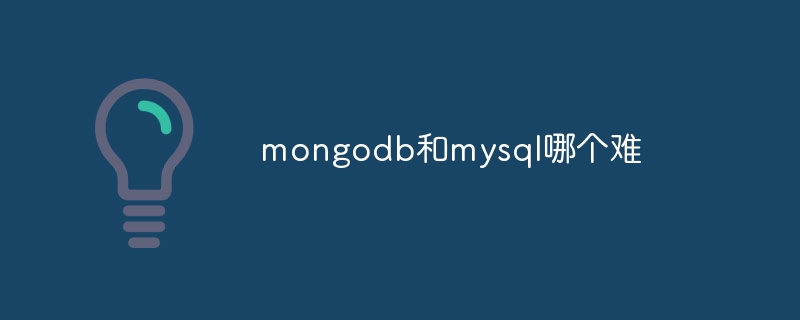Which one is more difficult, mongodb or mysql?
The difficulty of comparing MongoDB and MySQL depends on your background and needs. For beginners, MongoDB is easier to understand, but MySQL is more suitable for those with relational database experience. MongoDB has a simpler query language and flexible data model, while MySQL has a stricter schema and is better suited for join queries. MongoDB scales better but is not as fast as MySQL on some queries. Overall, MongoDB is suitable for beginners and applications that require flexibility, while MySQL is suitable for experienced people and applications that require strict schema.

MongoDB vs. MySQL: Which one is harder?
The difficulty of measuring MongoDB and MySQL depends on your background and specific needs.
Basic aspects:
For beginners without database experience, MongoDB's non-relational structure may be easier to understand than MySQL's relational structure. However, MySQL may be easier to understand for someone with a relational database background.
Learning Curve:
MongoDB’s query language (MongoDB Query Language) is relatively simple and easy to learn. In contrast, MySQL's query language (SQL) takes longer to learn and master.
Data modeling:
MongoDB uses a document model, which provides greater flexibility but lacks traditional schema constraints. For applications that require a strict data model, MySQL's relational model is more suitable.
Scalability:
MongoDB is known for its horizontal scalability, making it easy to distribute data across multiple servers. MySQL also supports scalability, but is not as flexible as MongoDB.
Performance:
MongoDB is faster than MySQL on certain queries (such as aggregate queries). However, MySQL performs better on join queries and other relational database-specific queries.
Overall:
MongoDB may be simpler for beginners with no database experience or for applications that require a flexible data model and horizontal scalability. MySQL may be easier to use for applications that come from a relational database background or require strict data schemas. It's important to evaluate both options based on your specific needs to determine which one is the better choice.
The above is the detailed content of Which one is more difficult, mongodb or mysql?. For more information, please follow other related articles on the PHP Chinese website!

Hot AI Tools

Undresser.AI Undress
AI-powered app for creating realistic nude photos

AI Clothes Remover
Online AI tool for removing clothes from photos.

Undress AI Tool
Undress images for free

Clothoff.io
AI clothes remover

AI Hentai Generator
Generate AI Hentai for free.

Hot Article

Hot Tools

Notepad++7.3.1
Easy-to-use and free code editor

SublimeText3 Chinese version
Chinese version, very easy to use

Zend Studio 13.0.1
Powerful PHP integrated development environment

Dreamweaver CS6
Visual web development tools

SublimeText3 Mac version
God-level code editing software (SublimeText3)

Hot Topics
 1359
1359
 52
52
 How do I create users and roles in MongoDB?
Mar 17, 2025 pm 06:27 PM
How do I create users and roles in MongoDB?
Mar 17, 2025 pm 06:27 PM
The article discusses creating users and roles in MongoDB, managing permissions, ensuring security, and automating these processes. It emphasizes best practices like least privilege and role-based access control.
 How do I choose a shard key in MongoDB?
Mar 17, 2025 pm 06:24 PM
How do I choose a shard key in MongoDB?
Mar 17, 2025 pm 06:24 PM
The article discusses selecting a shard key in MongoDB, emphasizing its impact on performance and scalability. Key considerations include high cardinality, query patterns, and avoiding monotonic growth.
 How do I use MongoDB Compass for GUI-based management and querying?
Mar 17, 2025 pm 06:30 PM
How do I use MongoDB Compass for GUI-based management and querying?
Mar 17, 2025 pm 06:30 PM
MongoDB Compass is a GUI tool for managing and querying MongoDB databases. It offers features for data exploration, complex query execution, and data visualization.
 What are the different types of indexes in MongoDB (single, compound, multi-key, text, geospatial)?
Mar 17, 2025 pm 06:17 PM
What are the different types of indexes in MongoDB (single, compound, multi-key, text, geospatial)?
Mar 17, 2025 pm 06:17 PM
The article discusses various MongoDB index types (single, compound, multi-key, text, geospatial) and their impact on query performance. It also covers considerations for choosing the right index based on data structure and query needs.
 How do I configure auditing in MongoDB for security compliance?
Mar 17, 2025 pm 06:29 PM
How do I configure auditing in MongoDB for security compliance?
Mar 17, 2025 pm 06:29 PM
The article discusses configuring MongoDB auditing for security compliance, detailing steps to enable auditing, set up audit filters, and ensure logs meet regulatory standards. Main issue: proper configuration and analysis of audit logs for security
 How do I use the MongoDB Compass GUI to manage and query data?
Mar 13, 2025 pm 01:08 PM
How do I use the MongoDB Compass GUI to manage and query data?
Mar 13, 2025 pm 01:08 PM
This article explains how to use MongoDB Compass, a GUI for managing and querying MongoDB databases. It covers connecting, navigating databases, querying with a visual builder, data manipulation, and import/export. While efficient for smaller datas
 How do I use auditing in MongoDB to track database activity?
Mar 13, 2025 pm 01:06 PM
How do I use auditing in MongoDB to track database activity?
Mar 13, 2025 pm 01:06 PM
This article details how to implement auditing in MongoDB using change streams, aggregation pipelines, and various storage options (other MongoDB collections, external databases, message queues). It emphasizes performance optimization (filtering, as
 How do I use MongoDB Atlas, the cloud-based MongoDB service?
Mar 13, 2025 pm 01:09 PM
How do I use MongoDB Atlas, the cloud-based MongoDB service?
Mar 13, 2025 pm 01:09 PM
This article guides users through MongoDB Atlas, a cloud-based NoSQL database. It covers setup, cluster management, data handling, scaling, security, and optimization strategies, highlighting key differences from self-hosted MongoDB and emphasizing




